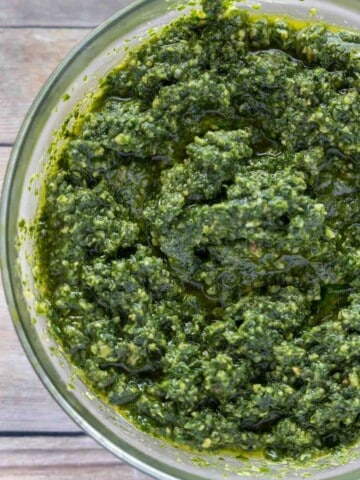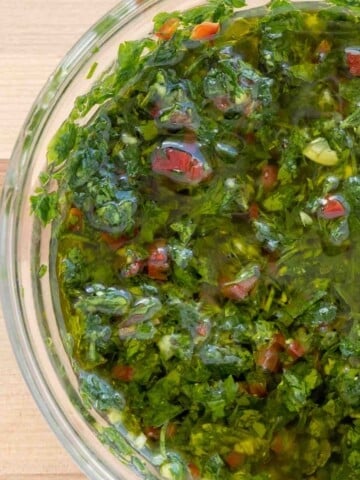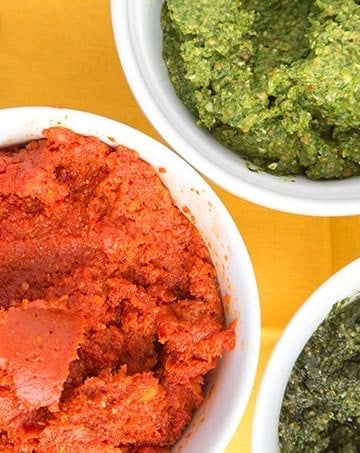If you’ve never heard of Sofrito before, you’re not alone. Although Sofrito is a staple in Caribbean and Latin American cuisine, it’s not necessarily part of most home cooks’ repertoire.
But trust me when I tell you it’s something you need to learn and start using. Sofrito is a versatile flavor base that adds depth of flavor and complexity to savory recipes like soups, stews, rice dishes, and so much more.

Sofrito was brought to the Americas and surrounding island nations by Spanish explorers and the settlers who followed. The first mention of sofrito was found in the Libre de Sent Soví, a cookbook from the Catalan region of Spain written in approximately 1324.
You’ll find many versions of this delicious creation. Our recipe is for the red version of a Puerto Rican Sofrito, which is a staple of Puerto Rican cuisine. You can also find a more herb-centered Green Sofrito known as a Recaito.
If you enjoyed this recipe, take a look at our Pesto Genovese and Chimichurri recipes.
Ingredients to make Sofrito

Let’s start by gathering the ingredients we need to make our Homemade Sofrito recipe. In Chef Speak, this is called the Mise en Place, which translates into Everything in its Place.
Not only does setting your ingredients up ahead of time speed the cooking process, but it also helps ensure you have everything you need to make the dish.
If your local grocery store doesn’t carry cubanelles and culantro leaves, check your local Latin grocery stores or Asian markets.
How to make Fresh Sofrito

- Rinse and clean all the peppers, removing the seeds and stems, then cut them into smaller pieces.
- Chop the onion down into small chunks.
- Smash and peel the fresh garlic cloves.
- Add the onions, cubanelle peppers, and the recaito to the bowl of a food processor and pulse for 1 minute.
- Add the garlic, sweet peppers, and cilantro to the food processor. Pulse for 1 minute or until the mixture looks somewhat uniform.
If the sofrito looks too chunky, slowly add olive oil to the mixture while the food processor is running until you reach the desired consistency.
*Be careful not to overmix the sofrito; a little chunky is okay; you don’t want a puree.

Think of Sofrito as the Latin American version of the holy trinity (peppers, onions, and celery) used in Cajun cooking or a mirepoix (carrots, onions, and celery) used in French cuisine.

Sofrito is an integral part of Puerto Rican cuisine and is used as a cooking base in many Puerto Rican dishes, such as the Arroz con Gandules (rice and pigeon peas) pictured above.
You’ll find so many ways to use our aromatic and savory sofrito. Soups, stews, rice dishes, pasta dishes, and as a condiment for roast pork (Pernil), chicken, and beef.

Leftovers should be stored refrigerated in an airtight container for 4-5 days. To store frozen, place the sofrito in an ice cube tray and freeze until solid.
Sofrito should have a similar consistency to pesto, like a thick paste. If it needs a little liquid, you can add a bit of water or olive oil while blending. But use as little as possible so the mixture doesn’t end up loose and runny.

When completely frozen, pop the sofrito cubes out of the ice cube tray and store them in a ziplock bag in the freezer for up to three months.
Recipe FAQ’s
Traditionally, sofrito is made with sweet cubanelle peppers (aji dulces peppers) and sweet green peppers. But you can use red bell peppers or sweet chili peppers to make the recipe.
For a spicier version, add some of your favorite hot peppers to the mixture.
Yes, you can. Most grocery stores stock a jarred premade version in the Hispanic section. Goya is one of the popular brands. You can also find it fresh or frozen. If your local grocer doesn’t stock sofrito, check your local Latin supermarkets.
If you’re using it as a base for any cooked dishes, it does need to be cooked and is usually how you’ll start preparing the dish.
If you’re serving it as a sauce or condiment, it can go either way. Raw, it has a fresh, robust taste; cooking will soften the flavors and create a more balanced flavor.









Virginia Stackhouse Peck says
I made this over the weekend. It was fabulous & I used it to start some Arroz con Gandules. I froze what I did it use for future use!
Chef Dennis Littley says
I’m happy to hear you enjoyed my Sofrito recipe!